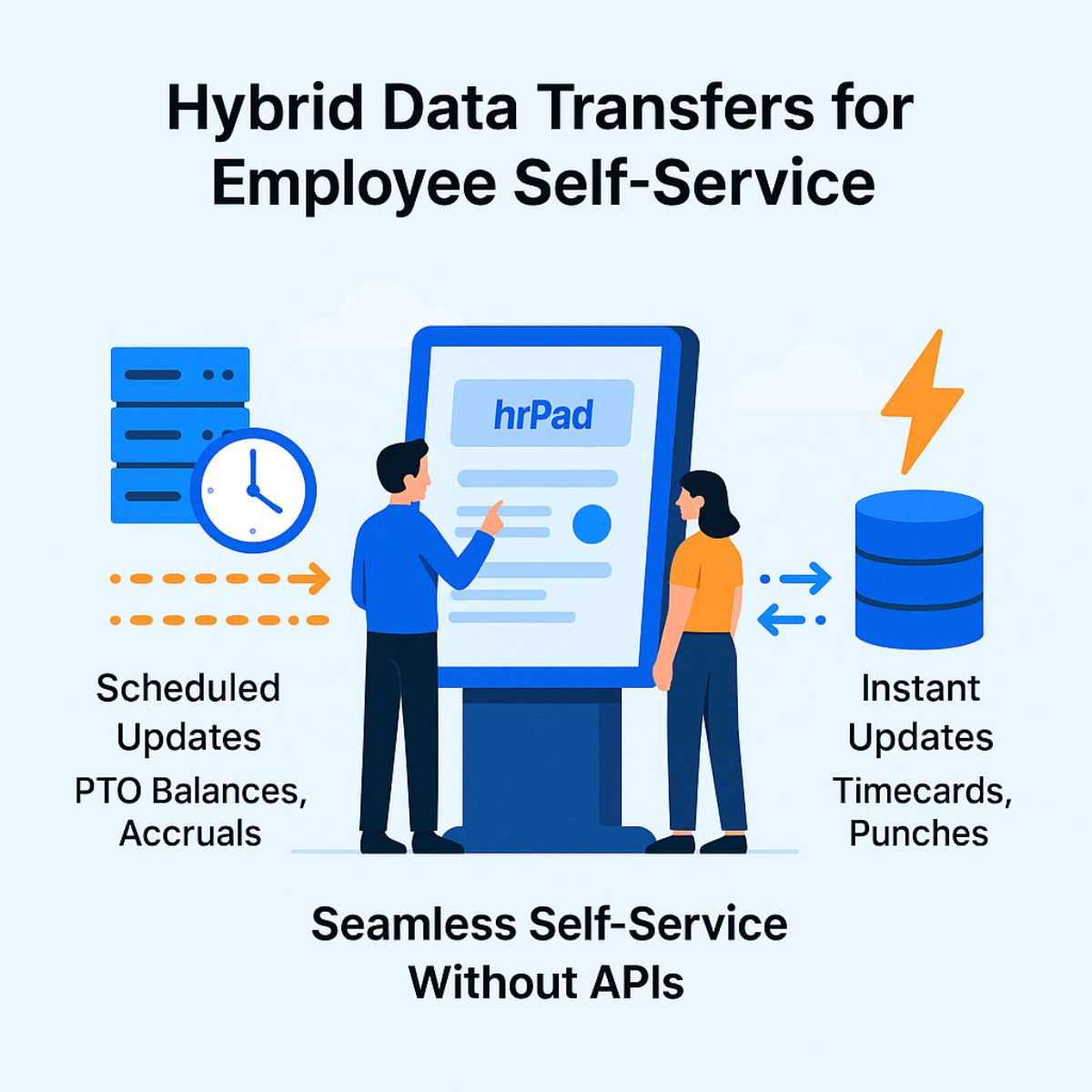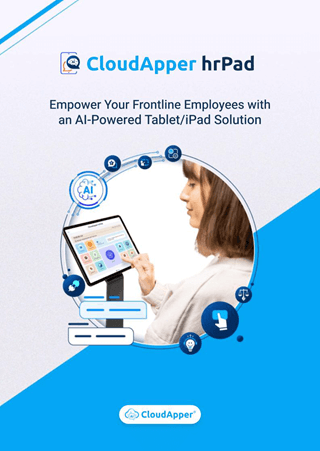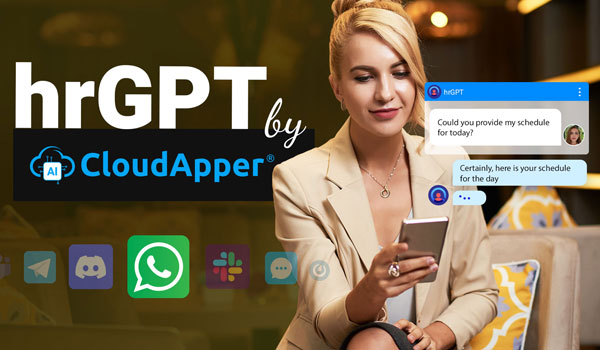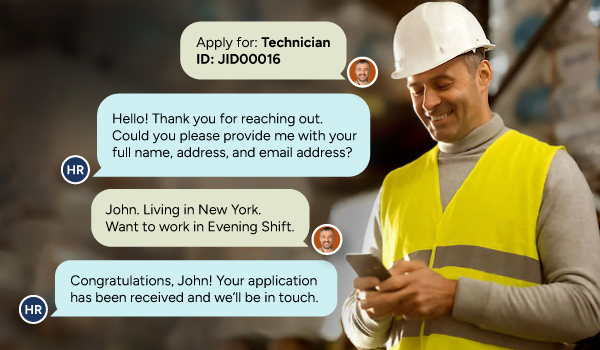Table of Contents
Employees today expect self-service tools that make work simpler. They want to see their timecards instantly, confirm PTO balances at a glance, and fix missing punches without waiting for HR. But here’s the challenge: many workforce management (WFM) systems still rely on older data transfer methods.
For more information on CloudApper hrPad visit our page here.
Systems like SBV WFM don’t offer public APIs, making real-time updates difficult. Instead, they depend on batch processing—scheduled jobs or flat file transfers that run every few hours or even once a day. For organizations aiming to provide a modern employee experience, the debate of real-time vs batch data transfers becomes critical.
This article breaks down the differences, explores what employees really need, and shows how CloudApper hrPad can deliver self-service without requiring APIs.
Understanding Real-Time vs Batch Data Transfers
Let’s start with the basics:
- Batch Transfers: Data is collected and moved in scheduled chunks—like every few hours or overnight. Think of it as a bus schedule: efficient for groups, but you may wait until the next departure.
- Real-Time Transfers: Data moves instantly as events happen. It’s like taking a car—direct, immediate, and personalized.
When it comes to employee self-service features like timecard visibility or PTO requests, the method you choose determines whether employees get an immediate answer or one that’s hours behind.
Limitations of Legacy WFM Systems Without APIs
Many WFM platforms were designed long before real-time APIs became standard. SBV WFM is one such example. It relies on a SQL-based setup without a public API, which makes real-time data flow harder to achieve.
Other systems with similar challenges include:
- Infor WFM (Workbrain): Popular in retail, but heavily batch-driven.
- ADP eTime (older versions): FTP transfers and scheduled jobs remain the norm.
- PeopleSoft Time & Labor: Known for batch data updates instead of instant sync.
These systems get the job done for core timekeeping, but they weren’t built for today’s self-service expectations.
Employee Self-Service Expectations Today
Employees no longer want to file requests and wait days for HR to respond. They expect to handle routine needs instantly. Common examples include:
- Checking “How many PTO days do I have left?”
- Reviewing last week’s punches to confirm accuracy.
- Submitting a missing punch request before payroll closes.
Without self-service, two problems arise:
- HR and payroll teams drown in repetitive inquiries.
- Employees grow frustrated and disengaged when answers aren’t immediate.
That’s why enabling employee self-service has become a top priority for forward-thinking organizations.
Pros and Cons of Batch Data Transfers
Pros:
- Efficient for processing large amounts of data at once.
- Less demanding on infrastructure.
- Suitable for information that doesn’t need instant updates, like PTO accrual balances.
Cons:
- Delays in data visibility frustrate employees.
- Missed punches or scheduling corrections take longer to appear.
- HR and payroll teams may still get questions because employees don’t trust outdated data.
Batch transfers are reliable but often fail to deliver the transparency today’s workforce demands.
Pros and Cons of Real-Time Data Transfers
Pros:
- Employees see their punches and timecards immediately.
- PTO requests and balances updates on the spot.
- Builds trust, reduces inquiries, and improves satisfaction.
Cons:
- Technical setup can be complex, especially in systems without APIs.
- Higher infrastructure demand compared to the batch.
- Not always supported by legacy WFM platforms.
Real-time transfers create the best employee experience—but they aren’t always achievable with older systems.
Finding the Balance: Hybrid Models
For many organizations, the solution lies in combining both methods. A hybrid approach allows you to use real-time updates where they matter most, and batch transfers where delays are acceptable.
Example:
- Punch data: Updated in near real-time so employees can confirm their hours immediately.
- PTO accrual balances: Updated nightly through batch transfers, since changes don’t happen minute-to-minute.
This balance delivers a self-service experience that feels modern while working within the limitations of legacy systems.
How hrPad Enables Self-Service Without APIs
This is where CloudApper hrPad makes a difference. hrPad turns any Android, iOS, or Windows tablet into a powerful employee self-service kiosk.
Here’s what hrPad enables:
- Timecard Visibility: Employees can check their hours anytime.
- PTO Balance Checks and Requests: Simple, transparent access to leave management.
- Missing Punch Submissions: Quick corrections without calling HR.
- Attestations and Surveys: Capture compliance and employee sentiment during clock-in/out.
And importantly: hrPad works without APIs. It integrates using SQL jobs, FTP transfers, or flat files—matching the capabilities of systems like SBV WFM, Infor WFM, or ADP eTime. That means you don’t need to overhaul your WFM platform to give employees the self-service tools they expect.
Security and Compliance Considerations
Any data movement must be secure, especially when dealing with sensitive workforce information. hrPad deployments include:
- VPN tunnels and IP whitelisting to control access.
- Encrypted SFTP transfers for secure data movement.
- Role-based access controls so employees only see their own information.
This ensures organizations extend functionality while staying compliant and protecting sensitive data.
Conclusion
The debate of real-time vs batch data transfers in WFM comes down to employee experience. Batch transfers may work for accruals, but real-time updates are essential for timecards and punch corrections.
Even if your system lacks a public API, you don’t have to sacrifice self-service. With hrPad, employees gain modern tools for timecards, PTO, and missing punch requests—while your IT team avoids costly migrations.
Ready to bring employee self-service to your workforce? Explore how hrPad can modernize your WFM system today.
What is CloudApper AI Platform?
CloudApper AI is an advanced platform that enables organizations to integrate AI into their existing enterprise systems effortlessly, without the need for technical expertise, costly development, or upgrading the underlying infrastructure. By transforming legacy systems into AI-capable solutions, CloudApper allows companies to harness the power of Generative AI quickly and efficiently. This approach has been successfully implemented with leading systems like UKG, Workday, Oracle, Paradox, Amazon AWS Bedrock and can be applied across various industries, helping businesses enhance productivity, automate processes, and gain deeper insights without the usual complexities. With CloudApper AI, you can start experiencing the transformative benefits of AI today. Learn More






















